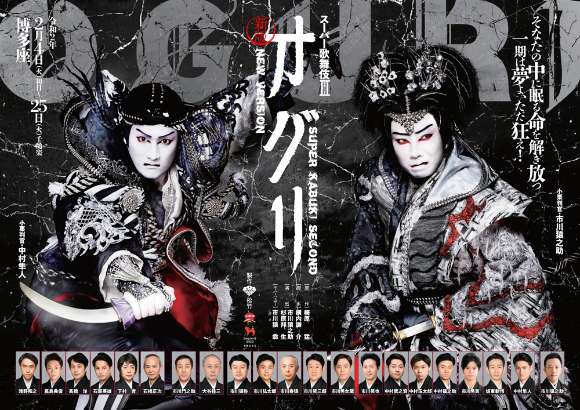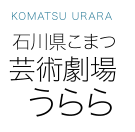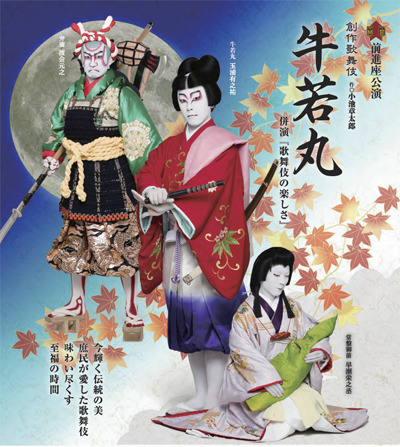| FEBRUARY 2020 |
|
2 shows in T˘ky˘ (Kabukiza), 2 in Fukuoka (Hakataza), 1 in Nagoya (Misonoza), 1 in Komatsu (Urara Theater Komatsu), 1 in Kanazawa (Kagekiza), in Ky˘to (Minamiza), 1 in Naruto (ďtsuka Museum of Art) and 1 tour (Zenshinza)!
|
| Kabukiza (T˘ky˘) |  |
| Dates | 2 ~ 26 February 2020 Nigatsu ďkabuki February Grand Kabuki |
| MatinÚe |
|
| Evening |
Hachijin Shugo no Honj˘ (Kosui Gozabune) Ninj˘ Banashi Bunshichi Mottoi Michiyuki Koky˘ no Hatsuyuki |
| Casting |
Living National Treasure Onoe Kikugor˘, Living National Treasure Kataoka Nizaemon, Living National Treasure Band˘ Tamasabur˘, Living National Treasure Kataoka Hidetar˘, Nakamura Tokiz˘, Nakamura Jakuemon, Nakamura Baigyoku, Nakamura Kaishun, Kataoka Gat˘, Nakamura Shikan, Nakamura Kankur˘, Kataoka Takatar˘, Onoe Sh˘roku, Ichikawa Danz˘, Ichikawa Sadanji, Band˘ Yajűr˘, Nakamura Karoku, Kataoka Kamez˘, Band˘ Shűch˘, Kataoka Shinnosuke, Nakamura Baishi, Nakamura Yonekichi, Nakamura Hashinosuke, Kataoka Sennosuke, Nakamura Mantar˘, Nakamura Kangyoku, Arashi Kitsusabur˘, Kataoka Matsunosuke, Ichimura Kitsutar˘, Nakamura Kichinoj˘ |
| Comments |
The February Grand Kabuki at the Kabukiza. 3 dramas are staged to commemorate the 26th anniversary (27th memorial services) of the passing away of Kataoka Nizaemon XIII: "Sugawara Denju Tenarai Kagami", "Hachijin Shugo no Honj˘" and "Michiyuki Koky˘ no Hatsuyuki".
|
 |
|
|||
| Dates | 4 ~ 25 February 2020 SűpÔ Kabuki Sekando Super Kabuki II |
||
| Program |
Shinpan Oguri |
||
| Casting |
Ichikawa Ennosuke, Nakamura Hayato, Band˘ Shingo, Ichikawa Monnosuke, Ichikawa Emisabur˘, Ichikawa Emiya, Ichikawa Omez˘, Ichikawa En'ya, Ichikawa Juen, Ichikawa K˘tar˘, ďtani Keiz˘, Nakamura Fukunosuke, Nakamura Takanosuke, Nakamura Tamatar˘, Ichikawa Otora, Asano Kazuyuki, Kashima Noritoshi, Ishibashi Sh˘ji, Shimomura Ao, Ishiguro Hideo, Takahashi Y˘ |
||
| Comments |
The SűpÔ Kabuki Sekando drama "Shinpan Oguri" is a revised version of 1991 SűpÔ Kabuki drama "Oguri".
|
||
 |
| ďtsuka Museum of Art (Naruto) |
| Dates | 13 ~ 16 February 2020 Sistine Kabuki |
| Program |
NOBUNAGA |
| Casting | |
| Comments |
10th edition of the Sistine Kabuki, a Kabuki program within the Sistine Hall of the ďtsuka Museum of Art, which is located in the city of Naruto (Tokushima prefecture). Inside this museum, there are more than 1,000 replicas of priceless masterpieces of Western art, from ancient murals to modern paintings, which are reproduced in ceramic to their original size. The Sistine Hall is of course a "reproduction" of the Vatican Sistine Chapel. |
 |
| Misonoza (Nagoya) |  |
| Dates | 31 January ~ 2 February 2020 Ichikawa Ebiz˘ Tokubetsu K˘en Ichikawa Ebiz˘ Special Performances |
| Program |
Goaisatsu |
| Casting | |
| Comments |
A special program starring Ichikawa Ebiz˘ in Nagoya at the Misonoza.
|
| Urara Theater Komatsu (Komatsu) |  |
| Dates | 8 ~ 9 February 2020 Ichikawa Ebiz˘ Tokubetsu K˘en Ichikawa Ebiz˘ Special Performances |
| Program |
Goaisatsu |
| Casting | |
| Comments |
A special program starring Ichikawa Ebiz˘ in Komatsu at the Urara Theater Komatsu.
|
| Kagekiza (Kanazawa) |  |
| Dates | 10 February 2020 Ichikawa Ebiz˘ Tokubetsu K˘en Ichikawa Ebiz˘ Special Performances |
| Program |
Goaisatsu |
| Casting | |
| Comments |
A special program starring Ichikawa Ebiz˘ in Kanazawa at the Kagekiza.
|
| Minamiza (Ky˘to) |
| Dates | 14 ~ 23 February 2020 Ichikawa Ebiz˘ Tokubetsu K˘en Ichikawa Ebiz˘ Special Performances |
| Program |
Goaisatsu |
| Casting | |
| Comments |
A special program starring Ichikawa Ebiz˘ in Ky˘to at the Minamiza.
|
| Hakataza (Fukuoka) |  |
| Dates | Ichikawa Ebiz˘ Tokubetsu K˘en Ichikawa Ebiz˘ Special Performances |
| Program |
Goaisatsu |
| Casting | |
| Comments |
A special program starring Ichikawa Ebiz˘ in Fukuoka at the Hakataza. Due to coronavirus (COVID-19), the performances from the 27th of February to the 1st of March were canceled!
|
| Zenshinza Tour | |
| Dates | 18 February ~ 1 March 2020 |
| Program |
Ushiwakamaru |
| Casting |
Tamaura Yűnosuke, Tadamura Shin'ya, Hayase Einoj˘, Matsunami Kihachir˘, Arashi Ichitar˘, Watarai Motoyuki |
| Comments |
A short tour for the Zenshinza troupe:
|
 |
|
|
| Contact | Main | Top | Updates | Actors | Plays | Playwrights | Programs | Links | FAQ | Glossary | Chronology | Illustrations | Prints | Characters | Derivatives | Theaters | Coming soon | News |